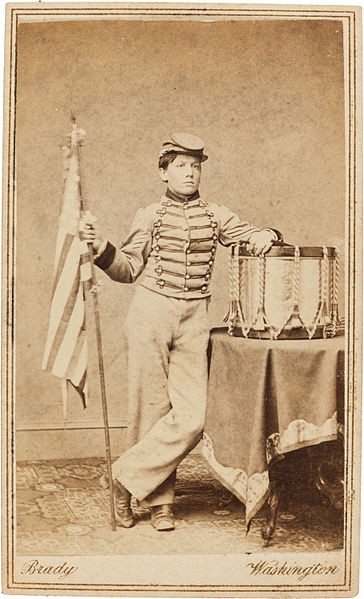
After the fall of Fort Sumter on April 14, 1861, many in Jackson, Michigan longed for the glory of battle. One of those who wanted to enlist was Robert Henry Hendershot, who would famously became “the Drummer Boy of the Rappahannock.” At first, Hendershot did not enlist. He, however, accompanied Company C of the Ninth Michigan Infantry to Fort Wayne, and then to the regiment’s first encampment at West Point, Kentucky. It is believed that he was either a stowaway or he acted as a servant to Captain Charles V. DeLand, the company commander. Hendershot remained with the company until he enlisted in Company B, 9th Michigan Infantry in March 1862, as a drummer boy.
Hendershot was with Company B during the First Battle of Murfreesboro on July 13, 1862, in Rutherford County, Tennessee, and he was taken prisoner. Hendershot was paroled along with the enlisted men, and he was discharged for disability as he suffered frequent and severe epileptic seizures. This did not stop Hendershot as he enlisted in the 8th Michigan Infantry in September 1862. Because of his parole, he signed on with an alias, “Robert Henry Henderson.” Hendershot suffered more seizures during his time with the 8th Michigan Infantry that the acting regimental commander, Captain Ralph Ely, had to order him off duty and apply for his discharge.
While awaiting discharge, he explored the Union encampment that contained the Army of the Potomac. Hendershot claimed to have helped push off the first boat then clung to the gunwale as the 7th Michigan Infantry crossed the Rappahannock River to Fredericksburg under heavy fire on Dec. 11, 1862.
A dispatch from the scene describes “a drummer boy, only 13 years old, who volunteered and went over in the first boat, and returned laden with curiosities picked up while there.” Reports appeared in the press, and the drummer boy remained nameless until late December, when Hendershot visited the offices of the Detroit Free Press and Detroit Advertiser and Tribune, claiming to be the “Drummer Boy of the Rappahannock.” The story was repeated in national papers. For the next eight weeks, Hendershot performed at the P. T. Barnum museum, then spent a few weeks more in Poughkeepsie, New York at Eastman Business College. His heroism was rewarded with a scholarship.
Hendershot was discharged from the Eight Michigan Infantry for epilepsy on December 27, 1862. In April 1864, he enlisted as a first class boy aboard the U.S.S. Fort Jackson at Hampton Roads, Virginia. While Hendershot claimed to be discharged from the Navy on June 26, 1864, the ship’s log listed him as a deserter.
By the end of the war, Hendershot had collected a portfolio of endorsements from Generals Burnside, Meade, Logan, Parkhurst, and President Lincoln, among others, recommending him for an appointment to West Point. Hendershot never went to West Point. He claimed he was denied admission to the academy because of his wounds or his inability to pass the entrance exams. However, no application exists for him in the academy’s records.
After a life full of controversy (mostly concerning the legitimacy of his claims of being “Drummer Boy of the Rappahannock”), Hendershot died of pneumonia on December 26, 1925.
http://www.historynet.com/americas-civil-war-drummer-boy-of-the-rappahannock.htm
